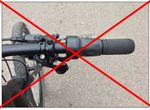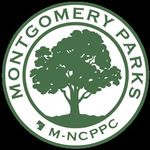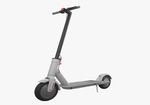MEMORANDUM April 29, 2019
←
→
Page content transcription
If your browser does not render page correctly, please read the page content below
MONTGOMERY COUNTY PLANNING BOARD
MARYLAND-NATIONAL CAPITAL PARK & PLANNING COMMISSION
MCPB Item #
05/09/2019
MEMORANDUM
April 29, 2019
TO: Montgomery County Planning Board
VIA: Michael F. Riley, Director of Parks
Mitra Pedoeem, Deputy Director of Administration
Jai Cole, Chief, Park Planning and Stewardship Division, (PPSD)
FROM: Hyojung Garland, Master Planner/Supervisor, Park & Trail Planning Section, PPSD
Charles Kines, Planner Coordinator, Lead Park Planner, Park & Trail Planning Section, PPSD
SUBJECT: Planning Board Discussion: Consideration of a Park Directive to establish a six-month pilot
program to allow e-bikes and e-scooters on certain, hard-surface “hiker-biker” trails on
Montgomery County parkland.
Staff Recommendation
Per the Park Rules and Regulations (adopted July 2017) and as specified in Chapter 1, Section 3, the Planning
Board will consider the proposed Draft Park Directive to establish a six-month pilot program to allow e-bikes and
e-scooters on certain hard-surface “hiker-biker” trails in Parks. (See Draft Park Directive, Attachment 1.) Staff
Recommendation: Approval.
Background
Electric bicycles (e-bikes) and electric scooters (e-scooters) are increasingly very popular for both transportation
and recreation in the U.S. Prices for these e-bikes and e-scooters have dropped to the point of making them
more affordable to purchase for personal/private use. In addition, companies like Lime, Bird, Jump, Skip, Spin,
Razor, and Lyft are deploying rentable, dockless e-vehicles at affordable rates throughout the Washington, D.C.
metro area. Commuters and the general public can now own or rent e-bikes and e-scooters for short trips to
places of employment, transit stations, central business districts or just for fun. Parks is interested in creating a
pilot program to allow both personal/private and commercial e-bike and e-scooter users on certain hard-surface
trails on Montgomery County parkland.
Montgomery County Department of Transportation (MCDOT) has been working on launching a Pilot Program to
expand dockless e-bikes and e-scooters in the County. MCDOT’s e-bikes pilot program continues to evolve to
meet demand. The 2019 MCDOT pilot will involve up to four commercial companies, last six months, and could
be extended for an additional six months. While MCDOT’s pilot areas are still being finalized, they are mostly
focused at Central Business Districts (CBDs) and in emerging Transit Oriented Development Areas. MCDOT is in
the process of finalizing an MOU with these companies that spells out boundaries, hours of operations, safety
trainings, preferred docking and parking areas, data collection, etc. The date of MCDOT’s launch is still being
determined but is currently planned for May 2019. See Figure 1 below for Draft Map for MCDOT Dockless
Vehicle Pilot Area.
9500 Brunett Avenue, Silver Spring, Maryland 20901 Phone 301.495.4605 Fax: 301.495.1320
www.montgomeryplanningboard.org Email: mcp-chair@mncppc-mc.orgFigure 1: Draft Map of MCDOT Pilot for Illustrative Purposes Only
Department of Parks Pilot Program
The Department of Parks is interested in studying the impact of e-bikes and e-scooters on its own hiker-biker,
hard-surface trails. Parks believes that it is in the best interest of potential users of e-bikes and e-scooters to be
able to utilize hiker-biker trails that pass through, touch or are adjacent to MCDOT’s pilot study area. Parks also
believes it makes sense to allow e-bike and e-scooter users to move across the full extent of a Park-owned hiker-
biker trail that may be situated within Montgomery County’s pilot areas, rather than expecting a user to know
the boundaries of any paper pilot study area.
As MCDOT’s launch date is uncertain, Parks is recommending its own six-month pilot E-bike and E-Scooter
program. If approved, Parks’ pilot will launch on June 1, 2019 and have two phases. Starting June 1, Phase 1 will
allow for the use of personally owned e-bikes and e-scooters of certain types on certain hard-surface trails.
Phase 2 will commence as soon as Parks has entered into contractual agreements with vendors to allow
commercial e-scooters and e-bikes on the same hard-surface trails. It is Parks’ intention to tailor the Phase 2
portion of Parks’ pilot to match that of the County as much as possible, and it is anticipated that Parks will enter
into an arrangement with the same vendors as the County. Parks also may request a six-month or similar
extension to continue to evaluate the Pilot. As much as possible, Parks’ program will run in tandem with
MCDOT’s. As an example, Parks’ extension might match the termination date of MCDOT’s pilot.
-2-The following hiker-biker trails are proposed for Parks’ pilot program and will be posted as such in public
noticing and through outreach on social media and the web:
• Rock Creek Trail – hard surface
• Sligo Creek Trail (within Montgomery County, not into Prince Georges) – hard surface
• Matthew Henson Trail – hard surface
• Long Branch Trail – hard surface
• Northwest Branch Trail Paved Sections (within Montgomery County, not into Prince Georges) – hard
surface
(See Figures 2 and 3)
Note that Parks’ Pilot Program will only include Class I e-bicycles and e-scooters that operate by rechargeable
battery. (See below.)
Public Outreach
If the Park Directive is approved, park users will be notified of the rule change by signs posted through
the park system with a focus on trailheads at major trail-road intersections. These signs will be posted
no later than two weeks prior to the program effective date and will include messages in English and
Spanish. The general public will be notified at least two weeks in advance of the program effective date
by a press release as well as website notices, social media posts and electronic newsletters distributed
by both M-NCPPC and Montgomery County government (e.g., Regional Service Centers, Paperless
Airplane, etc.).
In addition, Parks would develop necessary protocols for the effective implementation of its pilot program (e.g.,
working with commercial vendors and/or MCDOT to make available a safety training video, establishing areas of
preferred dockless parking, etc.). Park users and the general public are and will continue to be invited to
comment on Parks’ pilot. Comments will be collected on a Parks webpage devoted to this Program, as well as on
social media posts.
-3-Figure 2: Applicable Hiker-Biker Trails for Parks' E-bikes and E-scooters pilot program.
Figure 3: Zoom in of Applicable Hiker-Biker Trails for Parks' E-bikes and E-scooters pilot program.
-4-As the map illustrates, park trails recommended for the pilot are mostly laid out as North-South bound trails
within stream valley parks. One reason for Parks to do its own pilot is that park trail users’ travel patterns are
different than traditional transportation trips, and often involve going the length of trails rather than staying
focused within a commercial core. In addition, Parks wishes to first test the use of e-bikes and e-scooters on
certain hiker-biker trails before expanding their use potentially to busier hard-surface trails like the Capital
Crescent Trail that have a higher potential for user conflict. Use of these trails require more careful planning and
can be accommodated with lessons learned from Parks’ Pilot Program.
Evaluation and Analysis of Pilot Impact
It is essential to collect and analyze data from the pilot to understand the impact of e-bikes and e-scooters on
park trails. Parks will request aggregated user data from the commercial vendors. This data will include trip
duration and distance, patterns of use, safety, infrastructure, impacts, costs, etc. In addition, Parks will work
with MCDOT once its pilot has launched to learn from its data collection. Park Police also will employ standard
data and observation techniques since it will be essential to understand the impact of e-bikes and e-scooters on
existing users of these hiker-biker trails. Furthermore, park planners, working with Park Rangers and/or
volunteers, will conduct field observations at specific times during the course of the Pilot. The analysis of all this
data is imperative in informing sound policies and decision-making.
The following aspects are examples of data planned to be analyzed in order to understand if the pilot is a
success:
1) Conflicts with existing user groups
2) Safety
3) Infractions, violations, theft and/or other observations by Park Police and Parks staff
4) Operational challenges and logistics
5) Differences between personal users and commercial users
6) Public input on items in addition to those listed above
With accurate data on actual usage and the impact of e-bikes and e-scooters on existing users and park
operations, Parks and the Planning Board can make informed decisions about whether these dockless e-vehicles
should be: a) studied further; b) allowed permanently on the hiker-biker park trails studied; c) allowed for
certain types of users only; d) allowed on additional trails not included in the Parks Pilot Program (such as the
busy Capital Crescent Trail); e) not allowed on hiker-biker trails should there be valid reasons; or f) considered
and/or implemented in ways other than those noted above.
Park Directive
Chapter 5, Section 14 of the Park Rules and Regulations (adopted July 2017) prohibits the riding of motorized
vehicles on park trails, except when used for a disability or as authorized by permit or in areas expressly
designated by Park Directive and posted accordingly. Currently prohibited vehicles include electric bicycles,
motorized scooters, segways, hover-boards or similar motorized personal locomotive device. In order to
authorize e-bikes and e-scooters on the hiker-biker park trails identified in this staff report, a Park Directive is
required.
A Park Directive is a policy tool described in Chapter 1, Section 3 of the Park Rules and Regulations that allows
for a change to the Park Rules and Regulations in one county to allow certain activities on parkland for a certain
time in that county. The Parks Directive being presented at this time to the Planning Board will be the first in
Montgomery County, and will establish a Parks Pilot Program to authorize using e-bikes and e-scooters on
certain, M-NCPPC, Montgomery County hiker-biker (hard-surface) park trails named within this memorandum.
The Parks Pilot Program is intended to last for six months with the possibility of an additional six-month
extension or for a duration that matches MCDOT’s Pilot.
-5-This Park Directive only applies to Class I e-bicycles. Class II, Class III and Class IV e-bicycles will remain illegal to
ride on park trails. (See below.)
This Park Directive only applies to e-scooters that operate by rechargeable battery. E-scooters powered by
combustible (gasoline) engine, as well as any type of E-skateboard and E-hover-board regardless of motor type,
will remain illegal to ride on park trails, and are not included in this Park Directive.
Electric Bicycles (e-bikes) Definition
E-bicycles can be classified into four broad types:
Class I electric bicycles (Figures 4 and 5) have pedals and users can engage the electric power only when they are
pedaling, to give them a boost when climbing a hill for example. Class I e-bikes have a maximum speed of 20
mph.
Class II electric bicycles (Figure 6) often do not have pedals (although some do), and the user engages the motor
using a throttle on the handlebar, like mopeds and motorcycles. Class II e-bikes also have a maximum speed of
20 mph. The electric motor on a Class II e-bike can function independent of whether the rider is pedaling. A
rider can choose to pedal, ride using only the throttle, or both.
Class III electric bicycles are similar to Class I e-bikes, but have a maximum speed of 28 mph.
Class IV electric bicycles (Figure 7) are typically powered by a combustible (gasoline) engine and can often travel
as fast as a moped or motorcycle.
Figure 4. Step-through Class I pedal assist e-bike Figure 5. Regular bike on left, pedal assist e-bike
on right
Figure 6. Throttle-assist (Class II) Figure 7. Gasoline Powered (Class IV)
-6-Electric Scooters (e-scooters) Definition
E-scooters can be broadly classified into two main types: 1) those that are powered by re-chargeable battery;
and 2) those that are powered by a combustible (gasoline) engine. Only the first type will be allowed in the Pilot
Program (Figures 8 and 9.) Self-balance e-scooters are not allowed. (Figure 10.)
For the purposes of the proposed Park Directive, we are using the following definition from Maryland Senate Bill
770, which passed both houses to define e-scooters for the purposes of the Maryland Transportation Article:
An e-Scooter is a vehicle that: (1) is designed to transport only the operator; (2) weighs less than 100 pounds; (3)
has single wheels in tandem or a combination of one or two wheels at the front and rear of the vehicle; (4) is
equipped with handlebars and a platform designed to be stood on while riding; (5) is solely powered by a
battery-powered electric motor and human power; and (6) is capable of operating at a speed of up to 25 mph.
Figure 8. Typical e-scooter Figure 9. Typical e-scooter
Figure 10. Self-Balance Electric Scooter (Not allowed)
cc:
John Nissel, Deputy Director for Park Operations
Doug Ludwig, Chief, Northern Parks, Department of Parks
Bill Tyler, Chief, Southern Parks, Department of Parks
Darryl McSwain, Chief, Park Police Division, Department of Parks
Kristi Williams, Chief, Public Affairs & Community Partnerships Division, Department of Parks
Andrew Frank, Acting Chief, Park Development Division
-7-You can also read



























































